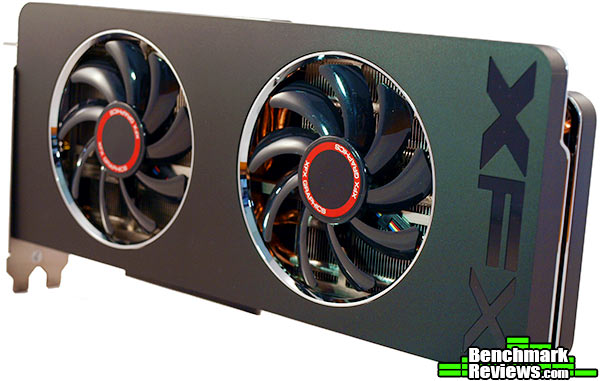PAGE INDEX
XFX Radeon R9 280X Black Edition Features
The XFX Radeon R9 280X Black Edition isn’t your standard R9 280X, if you couldn’t tell from the name. The XFX R9 280X TDBD is set apart first and foremost because of it’s factory overclock. The run-of-the-mill R9 280X is clocked the same as the Radeon HD 7970GHz Edition at 1000MHz (or 1GHz, thus the moniker). The XFX Radeon R9 280X Black Edition TDBD is clocked at 1080MHz, an 8% increase in clock speed over the stock R9 280X cards. But what else sets the XFX Radeon R9 280X Black Edition Video Card apart from the pack?
 One technology that XFX touts on the R9 280X TDBD is its Double Dissipation technology, which claims to provide temperatures up to 7 degrees cooler than the competition while also remaining 13dB quieter than the competition. The Double Dissipation technology is interesting to me. It uses a full-length heatsink with a single point of contact at the GPU. Three copper heatpipes channel heat away from the GPU. The heatpipes are each 7mm in size. XFX says that their Triple Direct Copper Heatpipes add one pipe over the competition, but I’m not sure who they are talking about when they say that. I’ve seen a lot cards with five heatpipes and some with four. For example, the HIS R9 280X IceQ X2 has five heatpipes, and the MSI R9 270X GAMING video card has four.
One technology that XFX touts on the R9 280X TDBD is its Double Dissipation technology, which claims to provide temperatures up to 7 degrees cooler than the competition while also remaining 13dB quieter than the competition. The Double Dissipation technology is interesting to me. It uses a full-length heatsink with a single point of contact at the GPU. Three copper heatpipes channel heat away from the GPU. The heatpipes are each 7mm in size. XFX says that their Triple Direct Copper Heatpipes add one pipe over the competition, but I’m not sure who they are talking about when they say that. I’ve seen a lot cards with five heatpipes and some with four. For example, the HIS R9 280X IceQ X2 has five heatpipes, and the MSI R9 270X GAMING video card has four.
 The XFX Double Dissipation also touts the Special XFX Exhaust Vent. Basically, that refers to the XFX logo cut into the bracket face. This supposedly provides 30% more exhaust airflow and by itself reduces temperatures by up to 2 degrees Celcius. It does look significantly more open than most bracket vents. The R9 280X TDBD also includes XFX’s Duratec components. Those consist of solid capacitors, ferrite core chokes, IP5X Dust Free fans, a 2oz Copper layer on the PCB, and lower RDS on MOSFETs.
The XFX Double Dissipation also touts the Special XFX Exhaust Vent. Basically, that refers to the XFX logo cut into the bracket face. This supposedly provides 30% more exhaust airflow and by itself reduces temperatures by up to 2 degrees Celcius. It does look significantly more open than most bracket vents. The R9 280X TDBD also includes XFX’s Duratec components. Those consist of solid capacitors, ferrite core chokes, IP5X Dust Free fans, a 2oz Copper layer on the PCB, and lower RDS on MOSFETs.
 Let’s talk about a feature I’m kind of in love with. It’s actually not just a feature of the XFX Radeon R9 280X Black Edition Double Dissipation Video Card, but one that spans the entire AMD Radeon RX 200 series of cards. That feature is the support for an additional TMDS (HDMI/DVI) interface. I’ll be honest, I buy inexpensive monitors. 30″+ and monitors with resolutions higher than 1080p are expensive. Sure, you can find some monitors with DisplayPorts, but I’ve bought five monitors in the last year and not a single one has a DisplayPort. It’s another $30 or so to buy an active cable to get another monitor to work. For those reasons, I’m excited that AMD added support for another TMDS interface. There is a catch, though.
Let’s talk about a feature I’m kind of in love with. It’s actually not just a feature of the XFX Radeon R9 280X Black Edition Double Dissipation Video Card, but one that spans the entire AMD Radeon RX 200 series of cards. That feature is the support for an additional TMDS (HDMI/DVI) interface. I’ll be honest, I buy inexpensive monitors. 30″+ and monitors with resolutions higher than 1080p are expensive. Sure, you can find some monitors with DisplayPorts, but I’ve bought five monitors in the last year and not a single one has a DisplayPort. It’s another $30 or so to buy an active cable to get another monitor to work. For those reasons, I’m excited that AMD added support for another TMDS interface. There is a catch, though.

AMD took the easy way out (read – less expensive) when adding support for another TMDS interface. Because DVI and HDMI interfaces are tied to their own clock generator, unlike DisplayPort, you would technically need to add another clock generator in addition to the two for TMDS device already present to be able to use another monitor. In the 200 series, AMD was able to use a single clock generator for multiple TMDS interfaces. Since the clock generator dynamically adjusts to the interface based on the display, however, the two displays must use identical clocks in order to function off a single clock generator. You’ll basically want to have two of the same monitor to use this feature, which is actually pretty ideal for Eyefinity.





Most Recent Comments